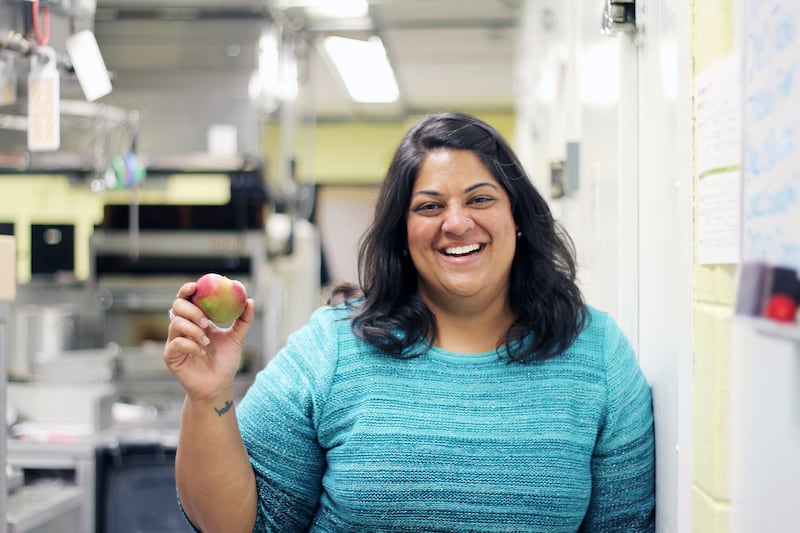“It makes sense that sick people get fed better food, but why is it so hard to pull off?” asked Canadian chef, author and activist, Joshna Maharaj, at a recent talk in Dublin on improving hospital food.

An inspiring speaker, she shared many anecdotes about her work as director of food services at two Toronto hospitals and on one university campus at a gathering of chefs and catering students keen to improve the quality of hospital food in Ireland.
Maharaj says one of the main reasons why standards of excellence in many hospitals are not applied to food is due to healthcare budget cuts from the 1990s that have not been reversed. “Feeding patients and staff often seems to be an irritating necessity and not connected to the fundamental role food plays in nurturing life,” she says.
“The problem in many hospitals is that administrators are not that concerned about the food service if patient satisfaction scores are average.”
READ MORE
Often these surveys are carried out just before a patient is discharged, rather than – as Maharaj suggests – at lunchtime on day two of their hospital stay.
[ Is this the best hospital food in Ireland?Opens in new window ]
While working at the hospitals in Toronto, she found ways to put more local food on patients’ plates and created a cooking-from-scratch food mandate, while emphasising the importance of cultural-appropriate food for different ethnic groups. “Not serving people familiar food impedes the healing process,” says Maharaj, as she tells stories about sourcing small apples from local farmers to replace peeled slices of apples in plastic bags.
She is appalled by doughnut cafes in hospital foyers and would like to replace hospital gift shops with a store selling healthy foods and kitchen utensils. “When someone is in hospital, it is a great time to educate them about their lifestyle and eating habits, so hospitals could function as a hub for better food.”

Maharaj’s gritty determination to change things in places she worked extended to getting the job descriptions of catering staff rewritten so that they could personally espouse a cooking-from-scratch philosophy rather than reheating frozen meals or cooking with ultra-processed prepared ingredients. “At one point, I couldn’t get petty cash to buy local potatoes so I bought them myself and brought in my own potato peeler to peel them only to run into trouble with the maintenance staff who didn’t know where to put the organic waste bin filled with potato peels.” She also bought a food processor so that she could give the patients who needed soft food the same meals as other patients.
She says that chefs in hospitals need to influence the administration to prioritise tasty food for patients. “I don’t believe it’s all about counting and measuring calories and nutrients. It’s about having food taste so good and you come back for more. If we can get good food into hospitals, we could create better culinary jobs there and a second career for chefs who are tired of the long hours in hotels,” says Maharaj.
Her audience at the event – organised by the Technological University Dublin with chef Domini Kemp at the Food Lab cafe in the VHI 360 Health Centre in Carrickmines, Dublin – were enthusiastic to make changes to hospital food in Ireland.
[ ‘Brain food’: Can eating certain things help prevent dementia?Opens in new window ]
Phillip Gleeson, executive chef at Kilashee House Hotel in Co Kildare, says there should be a training academy to teach chefs how to work in hospitals. “Hospital food doesn’t have a good reputation in Ireland. We need to promote hospital food as a professional career path for chefs,” says Gleeson, who has just completed a master’s in applied culinary nutrition at TU Dublin. “What’s on a patient’s plate is a reflection of the kitchen and there is a huge gap between the quality of hospital food in private and public healthcare.”
Shane Loughlin, head chef at the National Rehabilitation Hospital in Dún Laoghaire, is a former head chef in a Dublin hotel. “We are curtailed by regulations and HSE procurement issues. I have no control over the food budget in the hospital but I had control over it when I worked in the hotel,” explains Loughlin. That said, Loughlin works hard to “purchase the best ingredients and cook and serve the most nutritious foods we can”.
“We are different to an acute hospital because most patients are with us for a minimum of two months and I have personal interaction with them. We cook fresh food every day,” says Loughlin who feeds more than 300 people (staff and patients) every day.
[ How to eat and drink healthily, with tips from the expertsOpens in new window ]
Deborah Cullen, the catering manager at the Rotunda Maternity Hospital, was also at the event. She explains that in 2016, the hospital moved from plating up all patients’ meals at the main central kitchen to bringing it up to pantries on each floor and serving it from there. “It made a massive difference. The food is hotter. It doesn’t stick to the plates. It looks fresher and more vibrant as it hasn’t been sitting around for 40-50 minutes,” she explains. The Rotunda also recently introduced a digital patient menu with translations into Romanian, Polish and Portuguese.
“We speak to patients every day and can sometimes cook something for a patient off-menu. We also offer extra snacks and larger portions to breastfeeding mothers,” explains Cullen. And judging by social media posts, staff and patients alike are enjoying the improved quality of food there.
However, not all hospitals are gaining such positive feedback from patients. And sloppy scrambled eggs, sliced white bread sandwiches and wilted salad leaves are the fare that many patients still endure.
The HSE’s food, nutrition and hydration policy for adult patients in acute hospitals – which was launched in April 2019 – stated aim is to “improve the quality and safety of food and nutrition in hospitals”. But crucially, it doesn’t include a mandate on the requirements/specifications for the HSE food procurement tenders.
‘The most important thing for Irish hospitals is to have more freedom to buy produce from local suppliers’
Yet, Mary Flynn, past catering manager of Beaumont Hospital in Dublin, says that “the most important thing for Irish hospitals is to have more freedom to buy produce from local suppliers. Hospital caterers need to be able to think small and think local. Local suppliers will deliver food when you want them too which allows you to better control what you need and use your storage well.”
The bottom line is that patients need the best quality food that catering staff can cook for them. If hospital administrators aren’t prioritising fresh food in their budgets and instead buying highly processed ingredients bought at the lowest possible price, it’s virtually impossible for those cooking it to achieve high standards.
In Maharaj’s book, Take Back the Tray, she writes: “Food is linked to so many aspects of our daily lives… In a hospital, this is about wholesome, scratch-made food on patients’ meal trays. It’s about menus that are diverse and that support healing and wellness. But it’s also about communication from farms and kitchens with encouraging messages as patients get better.
“It’s a policy that protects mealtimes and uses volunteers to support patients to get food into their mouths with kindness and dignity. And it’s about opportunities for the whole hospital community to learn more about wholesome eating, sustainable farming and simple ways to cook themselves some good food.”













